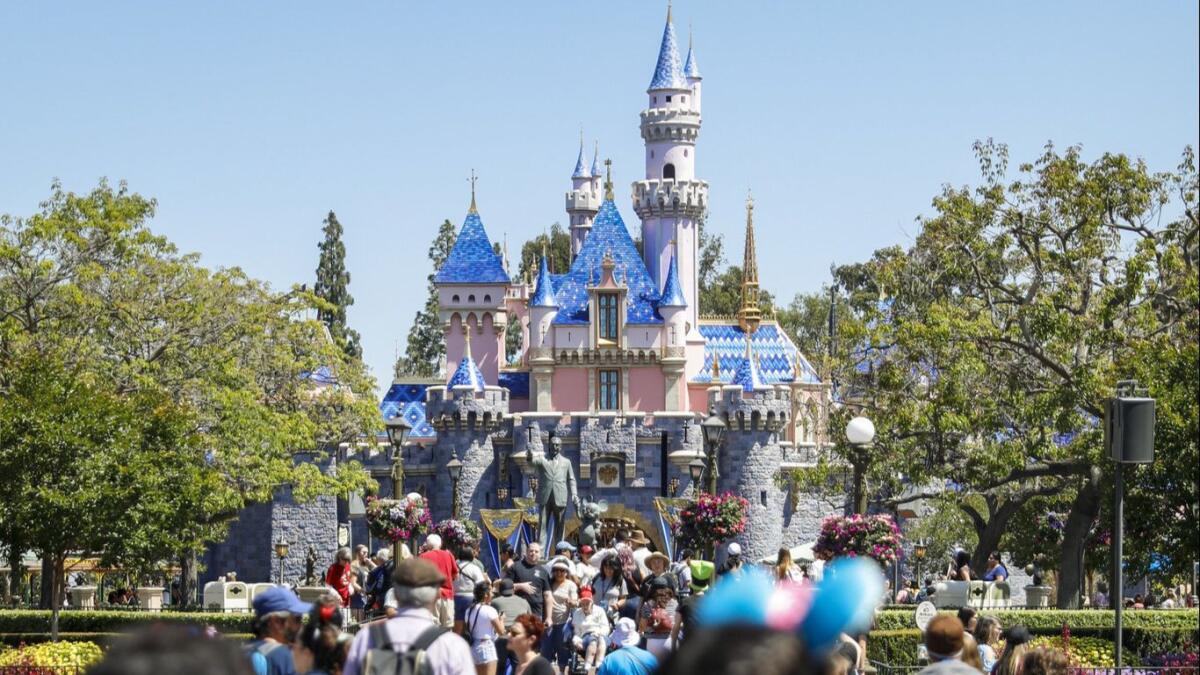Disneyland is tracking guests and generating big profits doing it

In the heat of the summer blockbuster season, Walt Disney Co. is taking over theaters with releases such as “Toy Story 4” and live-action versions of “Aladdin” and “The Lion King.” There’s another aspect of the season Disney is effectively capturing: summer vacations — and reams of data on the things people do inside its amusement parks.
With the recent opening of the Star Wars: Galaxy’s Edge attraction at Disneyland, the company continues to mine its portfolio of franchises and boost its $20-billion resorts business. Last week, Disney announced the opening of another extension at Disney World in Orlando, Fla., a follow-up to its massive Avatar annex. And next on the schedule is a slate of Marvel comics-themed attractions in Hong Kong and Paris.
As families float through It’s a Small World, run from Stormtroopers or snap a picture with Buzz Lightyear, Disney is watching their every move. It’s remarkable how much data Disney can collect in the process — and how willing people are to authorize such behavior. At a time when Facebook Inc., Alphabet Inc.’s Google and myriad other technology companies are getting hammered over consumer privacy issues, Disney is running the happiest surveillance operation on Earth.
To keep the parks running with extreme efficiency and learn ever more about guests, Disney monitors usage of its smartphone apps and electronic wrist-worn MagicBand. The resulting data could include the rides families frequent, the characters kids and parents are most drawn to and the television and film merchandise into which their dollars are funneled.
It wasn’t always this way. Just a decade ago, Disney relied on paper tickets and old-school turnstiles, and, for the most part, didn’t know that much more about resort customers than those who came to the park’s opening 64 years ago this week. Finally recognizing the growth of social media and mobile phones late last decade, the company embarked on a $1-billion digital transformation of Disney World with the MagicBand, a gizmo that can hold your place in line, make payments and unlock a hotel room door.
This journey has been fraught at times — and not just because Disney overspent on a wearable device that was quickly displaced by phones. In 2013, in the early days of the MagicBand, Disney Chief Executive Bob Iger was at loggerheads with Rep. Ed Markey (D-Mass.) — the privacy advocate who’s now a U.S. senator and recently introduced an internet bill of rights — over how the system would monitor children’s whereabouts and interests within Disney World. (Iger argued that the program was entirely opt-in and that location data was only collected in aggregate. Iger called Markey’s privacy concerns “ludicrous and utterly ill-informed.”) Even Facebook’s Sheryl Sandberg, a Disney board member at the time, once asked whether the MagicBand could track her own kids.
Despite these familial concerns, Disney’s data mining never faced the sort of scrutiny that Silicon Valley has. The reason is fairly simple: Disney World is the real-world manifestation of a walled garden, a family-friendly environment without a perceived risk of children being exposed to inappropriate content like on YouTube or Twitch. Wired once called this data-driven customer relationship “exactly the type of thing Apple, Facebook and Google are trying to build. Except Disney World isn’t just an app or a phone — it’s both, wrapped in an idealized vision of life that’s as safely self-contained as a snow globe.”
Unfettered access to customer data has helped Disney streamline its park logistics. The company has suggested the MagicBand enabled it to slash turnstile transaction times by 30% while increasing park capacity. At Disneyland, a new virtual reservation system, the first in the park’s history, has prevented overcrowding and reduced wait times. Even in the early weeks of its highly anticipated Star Wars-themed land, the line for the signature attraction, the Millennium Falcon ride, was a mere 25 minutes. Longer term, Disney’s “Imagineers” have suggested they want to leverage such guest data for more personalization and crowd-flow management.
At a higher level, this surveillance gives Disney insight into the value of its creative capital. The enthusiasm of patrons for certain physical attractions can signal which movie franchises are rising or falling in popularity. That could inform whether the Avengers can sustain more sequels, help promote the upcoming Disney+ streaming service or are in need of a refresh.
Whereas data-mining efforts have harmed the reputations of tech companies, Disney’s parks division is booming, with operating profit up 18% last year to $4.5 billion. Perhaps this explains why Disney is reportedly investing more into its theme parks than it spent to acquire Pixar, Marvel and Lucasfilm combined.
More to Read
Inside the business of entertainment
The Wide Shot brings you news, analysis and insights on everything from streaming wars to production — and what it all means for the future.
You may occasionally receive promotional content from the Los Angeles Times.










